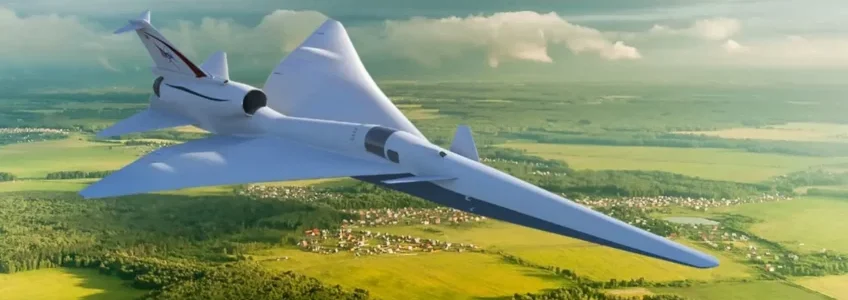The dawn of a new era in aviation is on the horizon. One that promises the thrills of supersonic flight, but without those deafening sonic booms. How, you ask? Enter the X-59 QueSST supersonic jet, an experimental marvel from NASA.
The Need for Speed – And Silence!
Fifty years back, the US government made a bold move, prohibiting civilian supersonic flights over land. Why? Those earth-shattering sonic booms were not exactly popular among the people below. While the jet-setters of yesteryears might have found the allure of flying faster than sound irresistible, for those on terra firma, it translated to rattling windows and potential property damage. Even if researchers of the 1960s and 70s were aware of the problem, their tech wasn’t quite up to the challenge of tackling it.
So, despite the lure of the skies calling, the supersonic jet ambitions had to stay grounded – until now.
Rise of the X-59 Supersonic Jet: A Sonic Thump, not Boom!
NASA’s X-59, a product of dedication, innovation, and engineering prowess, is ready to bring back the romance of supersonic jet travel. However, this time it promises a vastly quieter experience for those below. The sonic ‘boom’ is replaced by a mere ‘thump’—akin to the gentle shutting of a car door. A substantial improvement, wouldn’t you say?
This aviation marvel has been developed by the industry giants at Lockheed Martin Skunk Works in sunny Palmdale, California. Recent updates have it sitting poised on the flight line, with anticipation for its inaugural flight filling the air. Of course, a series of rigorous ground tests await before this supersonic bird takes to the skies.
Related: Supersonic Passenger Aircraft May Be Closer Than You Think
The Technology Behind the Dream
So, what sets the X-59 apart from its supersonic predecessors? Aerospace engineering, like many sectors, has witnessed groundbreaking advancements in the last few decades. From improved aerodynamic designs, advancements in materials and propulsion systems to innovative solutions for pilot safety, the X-59 incorporates them all.
For instance, the X-59 boasts a unique design, especially its sharp, elongated nose section, which astonishingly measures 38 feet! However, this quirky design also poses a challenge: the pilots can’t see directly ahead. But aerospace solutions are nothing if not innovative. The X-59 comes equipped with an External Vision System (XVS). This clever piece of tech, combining cameras and augmented reality, offers the pilot a crystal-clear forward line-of-sight.
Recommended: The X-plane: NASA’s Supersonic Jet Without The Boom
What Lies Ahead for the Supersonic Jet Dream
The overarching goal isn’t just about breaking sound barriers. It’s about studying and understanding public perception of this ‘sonic thump’. By flying the X-59 over various communities, NASA aims to gather reactions and hopefully provide data strong enough to lift the half-century-old ban. A future where the focus shifts from speed limits to noise limits isn’t just a dream. With the X-59, it seems it’s almost a reality.
Peter Coen, NASA’s Quesst mission integration manager, couldn’t have put it better, “We’re definitely ready to write a new chapter in the history of supersonic flight.”
In the ever-evolving world of aerospace technology, the X-59 stands testament to what can be achieved when innovation meets determination. The promise of faster, quieter and more efficient travel is on the horizon, and with it, a brighter future for supersonic aviation


Recent Comments